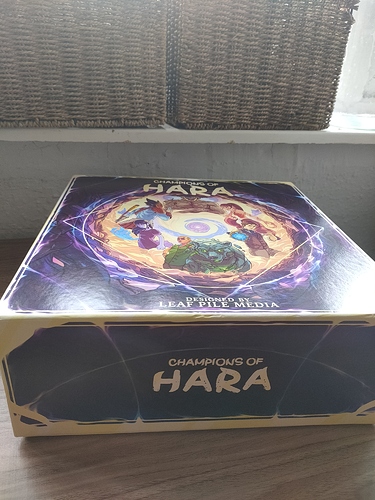OK, game finished.
In the words of my partner:
I really like this game, it is elegant.
And it is, it really is.
The board very quickly fills up with monsters and events, but the world shift changes the geography around so things never get stale or really predictable, and for me at least, the monster difficulty was just the right difficulty, i.e. requiring a bit of thought to overcome but not too much.
And by limiting the amount you can play in a turn (typically 3 cards, but sometimes more with certain abilities or cards) it forces some good, fun, brain crunching.
I played Persephone, who gains fear whenever she takes damage. Unfortunately I didn’t realise that was how she gained fear until day 4 (of 6) so I missed out on a tonne of juicy fear.
Fear amplifies some of your abilities, or can be spent to gain certain effects. It’s pretty cool.
And every character gets its own gimmick.
Next game I will play Leaf, or Mushroom Head as I call him, who generates and uses “momentum.”
I also like how monsters and events ar egenrated, i.e. at the start of each dawn period, genrate a card from each world.
At the start of each dusk period, generate 3 dusk cards.
And the end of each day (dawn and dusk period) activate one world card, which usually shifts the worlds around, so the dojo starts in the centre but ends up in various locations, which is fun.
Now, the not so good points:
Table space. This takes up a tonne of space, and managing your cards can get a bit fiddly because all cards start in your hand, and when you play a card, that card then goes on the table in front of you, and is now “on the board” which means when you play it next time, you use the lower ability of that card. And then it comes back to your hand.
So you can end up with a few cards in your hand, an a few on your deck, and forget you had cards on the deck as they are all in a row, which happened to my partner, which we realised when I saw a random card there and was wondering what it was.
Lastly, I haven’t played through them yet, but the scenarios look a bit anaemic. There are 3 per character, but divided into 2+, 3+ a solo player only, so, although again - I haven’t played this part yet - it does look a bit like this area needs fleshing out.
Also, there should be a handy turns reminder/aide-memoire, like the little cards you get in Spirit Island, to remind you that you must:
Day 1-
- spawn monsters and events,
- players play one adventure and one monster attack phase each, in that order.
- dusk phase, now spawn 3 dusk cards (roll die to decide location)
- players play one adventure and one monster attack phase each, in that order.
- End of day, activate a world card.
Day 2 - as above
Day 3, as above, except players gain their ultimate card at the start of the dusk phase.
These are pretty minor downsides, and after having come from the turgid and solemn solidity of Tainted Grail, and the slow brain burner of Spirit Island, via some frivolous minutes in Exploding Kittens and Go Sushi, this is a wonderful game to add to the collection.
And the rules mostly make sense.
